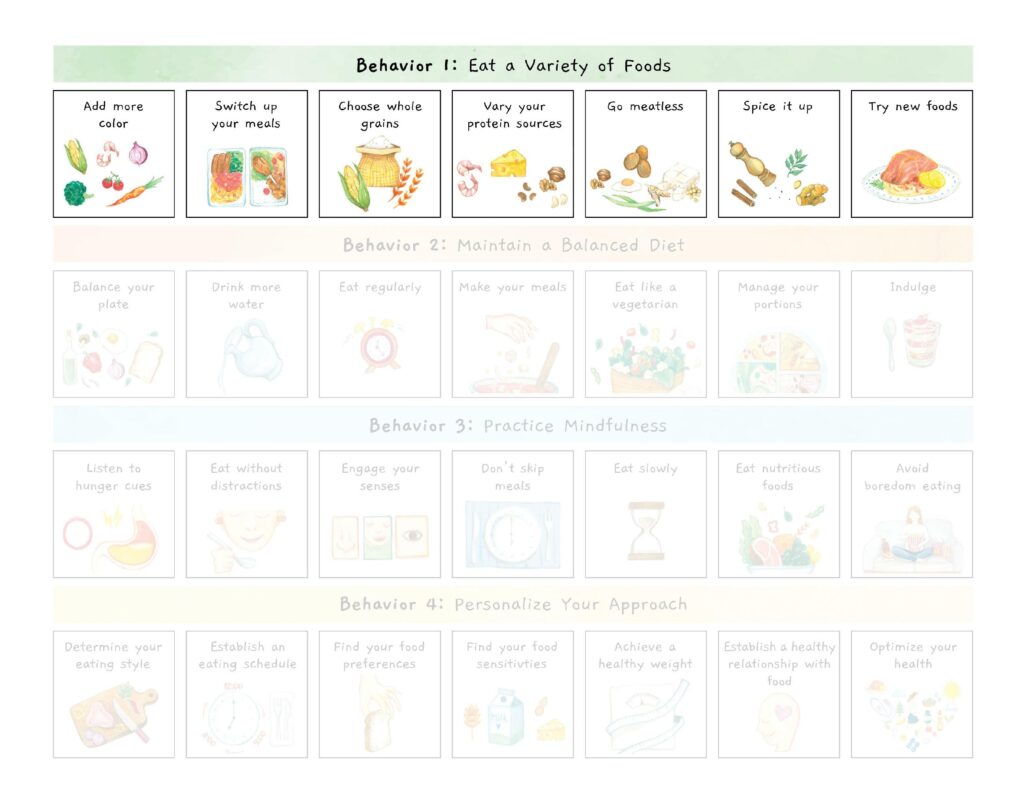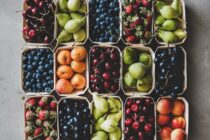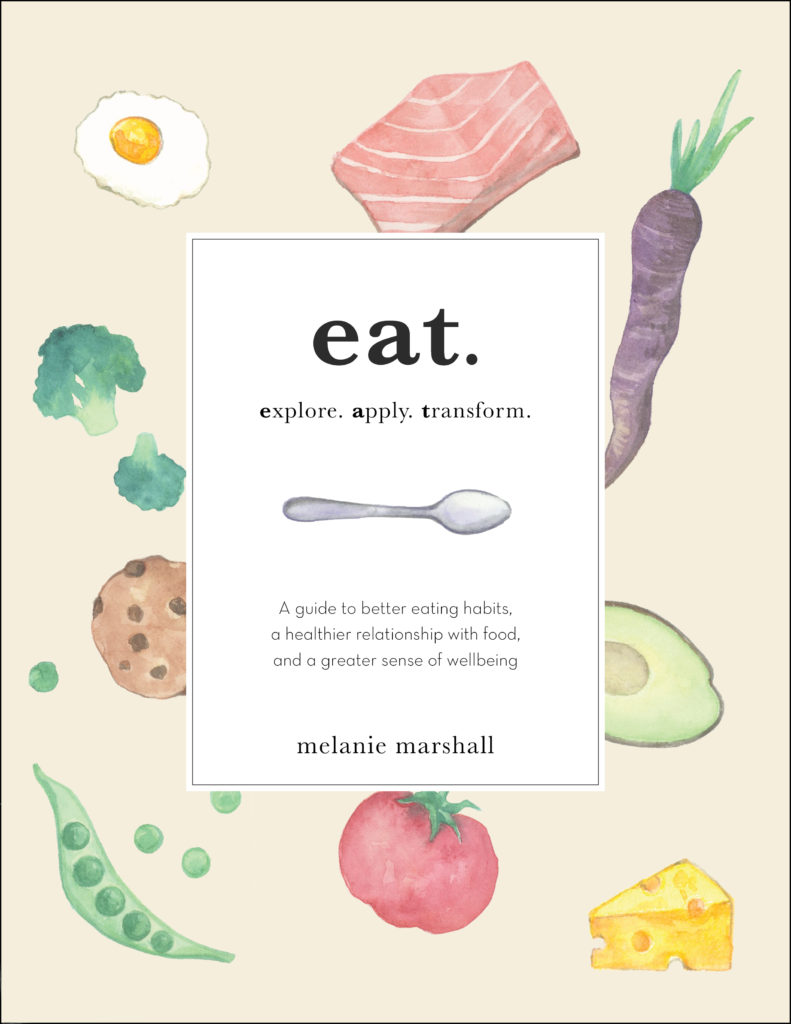When it comes to food, balance is everything: Balance of nutrients for nourishment, ingredients for taste, and different food types for pleasure. As such, it’s important to learn how to make food choices with each of these factors in mind. That is, you must be mindful to eat foods that nourish your body and allow yourself to eat foods that taste good and bring you pleasure (indulge).
Mindful eating
Finding a balance between nourishing and indulging is at the core of healthy eating. To adequately nourish and sufficiently indulge, a practice referred to as mindful eating, is the art of a balanced approach to eating. These two actions serve as the basis for healthy eating habits. Below is a summary of how this approach optimizes your health.
When you practice mindful eating:
- You’ll eat plenty of the healthy stuff, which means your body will have more nutrients to support optimal body function.
- You’ll be eating the foods your taste buds love, including the sweets, treats, and other salty snacks. Allowing yourself to indulge is what keeps you from binging or overdoing it in your weakest moments.
- You won’t have to avoid all social gatherings that involve food in fear that you’ll eat something not allowed in your diet. Social interactions are one of the most important factors in predicting physical health and wellbeing. The more social we are, the greater our sense of wellbeing.
- You’ll be more aware of how your food experiences make you feel. This will ensure that your interactions with food are positive, and it will leave you feeling happy.
In essence, adopting a balanced approach to eating does more than just promote physical health, it works to support all aspects of your health, and thus, promotes your overall wellbeing.
How to become a mindful eater
There are four behaviors associated with mindful eating. These behaviors include:
- Eat a variety of foods
- Maintain a balanced diet
- Practice mindfulness when eating and making decisions about food
- Personalize your approach to eating
Adopting these behaviors promotes a balanced approach to eating: an approach that, in my experience, has proven time and time again to be effective, sustainable, and best of all, enjoyable. The way to adopt these behaviors is by incorporating a range of healthy practices into your daily routine. These practices are illustrated in the chart below.
There are seven practices that coincide with each of the four behaviors. Each practice offers a great deal of flexibility and allows you to find a way of eating that best supports you and your evolving needs.
Incorporating these practices into your daily routine will help you build healthy eating habits and become a more mindful (intuitive) eater—a person who makes food choices without experiencing guilt, honors hunger, respects fullness, and enjoys the pleasure of eating. Those who succeed in mindful eating are not only better at managing their hunger but also tend to have a healthier relationship with food.

7 Practices to Build Healthy Eating Habits
To help you get started on your journey to becoming a more mindful eater, here are some examples of how to incorporate the seven healthy eating practices associated with behavior 1 (eat a variety of foods) into your daily routine.
1. Add more color

You can easily tell how balanced your diet is by looking at the color of your foods. The more color, the more balanced your diet. Try to get a variety of colors in all your meals and snacks. The easiest way to add more color is by eating fruits and veggies.
Have a cup of berries with yogurt or oatmeal in the morning. Eat a mixed green salad with chicken, peppers, tomatoes, corn, black beans, and avocado for lunch. Pack a banana or apple with nut butter for a snack. Make salmon, broccoli salad, and roasted root veggies for dinner.
Colorful foods are packed with micronutrients (vitamins and minerals). Colorful foods also contain phytonutrients—compounds found in plants that are beneficial to human health.
Many phytonutrients act as antioxidants. In your body, antioxidants fight against potentially harmful molecules called free radicals.
The phytonutrients found in fruits, veggies, and many other foods have been linked to reduced risk of disease and optimal body function. So, if you are looking to keep yourself healthy for years to come, maintain a colorful diet.
2. Switch up your meals

Though eating the same foods day-in and day-out can be convenient, it’s best to switch things up every now and again. This practice can prevent burnout and eating a variety of foods will ensure that you get all the nutrients your body needs to function at its best. Specifically, varying your diet will help you get more of those micronutrients and phytonutrients I talked about in the Add More Color section. You don’t have to eat an extravagant meal for breakfast, lunch, and dinner every day; it just means you should add new foods to your meals and snacks every now and then.
- If you are an eggs and toast for breakfast kind of person, try swapping the toast for oatmeal twice a week. Or keep the toast and get your protein from Greek yogurt with fresh berries.
- If you have a turkey and cheese sandwich for lunch every day, turn that sandwich into a salad (greens, chopped turkey, shredded cheese, avocado, peppers, etc.) and have crackers with hummus on the side.
- If you have chicken with some type of veggie and rice every night for dinner, swap out the chicken for salmon or pork. Or shred the chicken and throw it in a whole grain tortilla with lettuce, tomatoes, black beans, and cheese and top it with salsa and guacamole for a Mexican-style dinner.
Need some inspiration? Look online and get ideas from food blogs or Pinterest. Or create a weekly meal plan using recipes from food magazines. The options are endless; you just have to do a little planning.
3. Choose whole grains

Whole grains (e.g., brown rice, quinoa, and oats) are grains that have not been processed, which makes them more nutritious than refined grains (e.g., white rice and white bread). While processing refined grain, parts of the grain with fiber and other important nutrients are removed.
By swapping refined grains for whole grains, you get more fiber in your diet (good for digestive health) and more nutrients like B vitamins (important for metabolism).
You’ll also see the name enriched grains in the ingredient list sometimes. Enriched grains are refined grains with iron and a few of the B vitamins added back after processing. When choosing grains, it’s best to reach for whole grains first, then enriched grains, and then refined grains.
Here are some examples:
- For breakfast – eat a bowl of oatmeal; make banana nut protein muffins with oats or quinoa flakes; have a bowl of cereal (look for a cereal with 3 grams or more of fiber and less than 10 grams of sugar per serving); top your Greek yogurt with oats, granola, and/or cereal made with whole grains; or have a piece of whole grain toast topped with avocado and fried eggs.
- For lunch – eat a turkey hummus wrap using a whole grain tortilla; make a rice bowl with brown rice or quinoa and top with chicken and other roasted veggies; or make a deconstructed sandwich using whole grain crackers, turkey, sliced cheese, and hummus.
- For snacks – try peanut butter and banana on a whole grain tortilla, whole grain crackers with cheese or hummus, popcorn, bran muffins, granola bars (look for options with low sugar and high fiber), or Greek yogurt with granola.
- For dinner – make chicken enchiladas using whole grain tortillas, eat a grain salad and use wheat berries as your base, make some ground turkey and quinoa chili, have salmon with roasted asparagus and wild rice, or make your favorite pasta dish with half whole wheat pasta and half regular pasta.
4. Vary your protein sources

Protein is found in many foods. Both animal and plant proteins are made up of about 20 amino acids. Each protein contains varying proportions of each, but all food proteins contain some amount of each amino acid.
Amino acids are used to build the protein structures of your cells and are required for many other body functions, such as muscle building and immune system regulation.
Nine of the amino acids are considered essential, meaning they are not made by your body and must be obtained through your diet. The other eleven amino acids are considered non-essential as they can be made by your body. There are several non-essential amino acids that are classified as conditionally essential, meaning they become essential under specific conditions (e.g., stress or illness).
To ensure you get adequate amounts of the essential amino acids, as well as other nutrients that support body function, it’s important to eat a variety of protein sources. Below is a list of foods that contain protein.
- Fish is a great protein source that contains omega-3 fatty acids (good for heart health).
- Red meats, fish, and poultry contain a more readily available source of iron (needed to transport oxygen in the blood) versus the iron found in plant foods like spinach.
- Nuts and seeds contain healthy fats and are good sources of vitamins, minerals, and phytonutrients.
- Dairy products like cheese, milk, and yogurt are also a good source of protein and contain nutrients such as calcium and vitamin D (which help maintain strong bones) and vitamin A (which supports skin and eye health).
- Legumes like beans, peas, and lentils are a good low-fat source of protein and fiber. They are also packed with vitamins and minerals such as folate, iron, potassium, and magnesium.
5. Go meatless

Meat is definitely an easy source of protein and is often the centerpiece of many meals. A very normal menu for a day may include bacon and eggs for breakfast, a chicken salad for lunch, and beef stew for dinner. But it’s a good practice to go meatless occasionally. Venturing out and getting protein from different sources like nuts, beans, and lentils is a good idea, since it forces you to try new dishes and means you get a wider variety of nutrients in your diet.
Make it easy on yourself and build “Meatless Mondays” into your weekly meal plan. If you aren’t a meal planner, just keep foods like beans, lentils, and eggs on hand so your meatless meal isn’t protein-less.
Throwing together your favorite pasta without the chicken or meatballs doesn’t quite meet the standards of a balanced meal. Instead, make a stir-fry using edamame or tofu. Or make a vegetarian chili by cutting out the ground beef and adding an extra can of beans or a cup of quinoa.
6. Spice it up

Want to make your food taste better without adding a bunch of butter or salt? Sprinkle on the spices. Many spices have strong flavors, are packed with micronutrients and phytonutrients, and, because they are often used in small quantities, add very few calories to your food.
A spice can be a seed (e.g., nutmeg, mustard, or pepper), fruit (e.g., cayenne pepper), root (e.g., turmeric or ginger), bark (e.g., cinnamon), or other plant substance. Spices come in many forms: fresh, whole, dried, or pre-ground dried. You can add flavor using herbs, which can be found dried or fresh. Herbs are the leaves, flowers, or stems of plants.
Spices, along with dried herbs, are best added early on in cooking so the flavors can diffuse into the dish you are cooking. Fresh herbs are great for garnishes and provide bold flavors. They also work well for roasting and sautéing.
7. Try new foods

Everyone has their favorite foods. But that doesn’t mean you shouldn’t try new foods, especially as an adult. As a child, you probably obsessed over sweets and enjoyed dishes with simple flavors and textures. But as you grew older, you likely found yourself taking to more complex flavors, like the sweet heat from your favorite Indian curry or the subtle notes of cedar and clove in your black coffee.
Your taste buds change as you age, which means even if you didn’t like something as a kid, you should probably give it another chance as an adult. Also, be open to new flavor profiles. You might not like fish on its own, but if it’s seasoned well and paired with some delicious side dishes or as part of a pasta dish, you might find that you actually enjoy it. You might not like raw carrots, but that doesn’t mean you won’t like them if they are cooked and eaten with meat and potatoes in a stew.
Bottom line: Don’t write foods off just because you had one bad experience or because they don’t resemble anything you’ve tried before. Trying new foods, or trying new methods of cooking a food, is a great way to vary your diet.
Recap
A balanced approach to eating promotes a healthy body and a happy mind. Mindful eating is at the heart of this approach, a practice that involves eating for nourishment as well as for pleasure.
When you commit to the practice of mindful eating, you make better food choices daily, which means better eating year-round and less time spent trying to undo unhealthy eating habits. Healthy eating year-round is not only more enjoyable than dieting but is essential when it comes to maintaining your health and achieving your fitness goals.
To become a more mindful eater, find ways to incorporate the seven practices discussed in this article into your daily life. Making these choices routinely is the key to forming healthy eating habits, adopting health-promoting behaviors, and optimizing your wellbeing.






